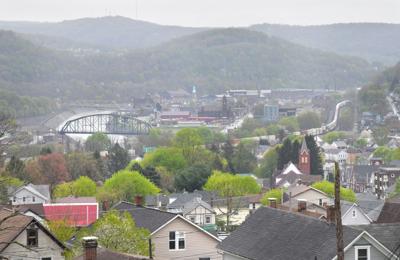Cambria County’s estimated population has fallen by 1 percent over the past year, new U.S. Census figures show.
Federal data reflect a county – counted as the Johnstown metropolitan area – that saw a decline of 1,324 people from 2017 to 2018, continuing a decades-long trend and keeping Johnstown among a pack of “Rust Belt” communities, much of western Pennsylvania included, that continue to see that downward trend.
“The population changes in Cambria and the Southern Alleghenies region are largely due to global economic forces beyond anyone’s control locally,” said Cambria County Planning Commission Executive Director Ethan Imhoff.
“Even Pittsburgh continues to lose population – 5,740 people in the same time frame,” Imhoff said.
The latest estimate puts the Johnstown metro area at 131,054 residents.
“It’s difficult,” state Rep. Jim Rigby, R-Ferndale, added. “But this isn’t something new we’re up against.”
If there’s a positive to be found within this year’s figures, it’s that area’s total estimated 1,324-resident decrease was one of its lowest over the past decade, following a five-year period that saw annual losses of an average of nearly 1,700 residents.
Local leaders across the region say they are working to slow and eventually reverse that trend by focusing on a broad scope of economic development and quality-of-life efforts aimed at attracting and retaining younger generations of residents through downtown development and enhanced outdoor recreation offerings.
The 2018 numbers provide a reminder – if not a warning – to communities that the high-stakes 2020 census – is less than a year away.
Regional realities
Over the past eight years, Cambria County’s total estimated population change subtracted 11,951 people from the area – an 8.3 percent drop.
The move signals that Cambria will fall well below the 145,000 threshold for fourth-class counties. But that must be certified over two consecutive decennial censuses before any changes would occur.
The 2018 estimates are based on 2010 census data, as well as new administrative records on births, deaths and other information.
Like Johnstown and Cambria County, most of the metropolitan and micropolitan areas around the city have continued to see population drops over the past year, with most of western Pennsylvania home to an older population – with deaths outpacing births.
The Altoona metro area, which comprises Blair County, dropped another six-tenths of a point to 122,492 people, according to 2018 Census figures.
Indiana’s population fell four-tenths of a point, to 84,501, while the Somerset micropolitan area – all of Somerset County – dropped by .5 percent last year to 74,356 people.
Rust Belt and Appalachian mountain cities such as Danville, Illinois, Charleston, West Virginia, and Weirton, West Virginia, were among the nation’s leaders in population losses, alongside places such as Farmington, New Mexico, and Pine Bluff, Arkansas.
Changing the message
Cambria County has been losing population for 70 years.
Reversing that trend won’t happen overnight, Cambria County Commissioner Thomas Chernisky acknowledged.
But with new growth along the Route 22 corridor, ramped-up investment in natural gas – including the development of the CPV Fairview plant – and the medical marijuana industry planting local roots, there are a growing number of opportunities to retain homegrown talent and to lure others to the Laurel Highlands, he said.
The region is also taking advantage of its rugged terrain and waterways with a growing number of outdoor opportunities on local roads, trails and rivers.
Hanging Gardens will soon open a medical cannabis growing and processing facility that could employ more than 200 people in the coming years, while Harvest of Southwest Pa. and Franklin BioScience are preparing to open dispensaries just a few blocks away in downtown Johnstown.
Among Mount Aloysius College, St. Francis University, the University of Pittsburgh at Johnstown and Pennsylvania Highlands Community College, more than 6,000 graduates are entering the workforce each year – many of them looking for opportunities in fields where jobs are available locally, Chernisky said.
“We need to (continue to) work on retaining those students and promoting the positive aspects of Cambria County,” he said.
Rigby agreed.
He pointed to a recent chat with local CareerLink leaders on the fact that there are 1,400 unfilled jobs in the region – careers in the trades, nursing and elsewhere – as proof that the talk “that a lack of jobs is driving people away” is no longer true.
“There’s a lot of great things happening here – and I’m hopeful over the next year or two, with some of the things we’re working on, everybody’s going to see it,” Rigby said. “I still see this community’s cup as half-full, and I think we’re going to start seeing our population numbers trending in the other direction.”
Costs and amenities
Chernisky said the county has done its part by cutting taxes two years in a row while eliminating a $9 million deficit – moves that have “fostered a spirit of collaboration” that could lead to other efforts across the region.
As planning commission director, Imhoff is among those tasked with developing a countywide comprehensive plan that aims to encourage new growth.
He is also part of a regional effort mirroring that to capitalize on the strengths of a six-county Southern Alleghenies Region – Cambria, Somerset and Bedford counties included.
Imhoff noted that the area’s natural assets can play a crucial role in that effort.
Efforts have begun to link popular trails such as the Path of the Flood, Ghost Town and Jim Mayer Riverswalk and to increase the area’s draw as a September 11 National Memorial Trail attraction.
At the same time, efforts have been underway to extend one leg of the trail through downtown Johnstown, open up the city’s waterways to the public and capitalize on newly-opened mountain biking trails alongside the Inclined Plane.
Economic development leaders have been working to rebrand Greater Johnstown as a “Mountain Town” for its outdoor offerings, which have been attracting attention from recreation-minded publications such as Blue Ridge Outdoors Magazine in recent months.
“The countywide emphasis on recreation is incredibly important,” Imhoff said.
“Younger people, especially those with in-demand skill sets, view recreation as standard infrastructure ... and Cambria County has a lot to offer in this space.”
2020 on horizon
The latest numbers also signal “the big one” is approaching in 2020.
The once-a-decade federal census is more than a headcount. Programs such as Medicaid, the National School Lunch Program, Highway Planning and Construction and Head Start all receive funding at the state and local levels through formulas reliant on census figures.
The Census Bureau itself has invested major funding and resources in recent decades to draw attention to that fact and to urge residents to cooperate with census-takers. Still, an estimated 1.5 million minorities, black and Hispanic Americans included, and other “hard-to-reach” people, such as renters and young men in general, were “missed” in the 2010 count, the bureau’s follow-up assessment determined two years later.
Some communities are already taking steps to try to ensure properties, apartments, and most importantly, residents, aren’t missed next time.
The National League of Cities, its leaders well aware that urban areas are some of the most likely to be under-counted, has created an “action plan” to help cities prepare for 2020.
“The (census results) play a crucial role in determining how more than $800 billion of federal funding is distributed and allocated annually across state and local government,” League of Cities officials wrote, urging communities to empower themselves and their neighborhoods.
Locally, Windber Borough adopted landlord registration guidelines earlier this spring, requiring property owners to provide a list of names of all tenants in every occupied unit.
In defending the move, borough Manager Jim Furmanchik cited the need to ensure that all residents are counted in the upcoming census. A drop below 4,000 residents could strip thousands of dollars in annual Community Development Block Grants annually from the town.
“We can’t afford to lose that,” he said in March, noting that those funds are used for redevelopment and blight removal efforts.
‘Educate people’
Communities across the nation have started to form Complete Count committees to begin working through obstacles and engage key players needed to ensure accurate population counts in their neighborhoods.
That needs to happen in communities such as Johnstown, too, City Manager George Hayfield said.
Hayfield said he met with local Census Bureau representatives on Wednesday to begin taking steps to make city residents aware of the count’s importance, and to increase the likelihood that they get counted.
As the census moves toward online methods of self-reporting, Hayfield said he is worried that the city’s high number of retirees might not get counted if the right steps aren’t taken.
“We’re going to have to get a lot of ads out there,” Hayfield said. “We’re going to have to educate people – basically beat it into them about how important this is.”






























Commented
Sorry, there are no recent results for popular commented articles.